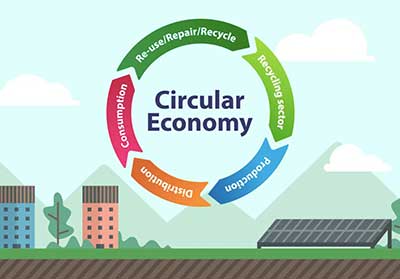Relevance: GS-3: Conservation, environmental pollution and degradation, environmental impact assessment.
Key phrases: Circular Economy, Renewable Energy, IRENA, Sustainable Energy Future, Solar Capacity, Net-Zero Target, Waste Management and Recycling Ecosystem, Extended Producer Responsibility, Landfilling, Leaching of Heavy Metals, Recycling Technologies, Innovative Financing.
Why in News?
- In the Budget speech this year, the Finance Minister, Nirmala Sitharaman, emphasised the role of cleaner technologies such as solar energy and batteries in India’s future economic growth. In addition, she mentioned the importance of transitioning to a circular economy from the existing linear one.
Context:
- The call for a creation of a circular economy is significant since an efficient waste management ecosystem would be necessary to manage the enormous waste generated by renewable energy projects in the coming decades.
- According to the International Renewable Energy Agency (IRENA) — an intergovernmental organisation that supports countries in their transition to a sustainable energy future — the cumulative waste generated by India’s total installed solar capacity could be as high as 325 kilotonnes by 2030.
- A consulting firm, JMK Research and Analytics, estimates that the market for battery recycling will be around 23 Gigawatt hours (GWh) by 2030. The prevalence of a circular economy could also partially insulate these industries from potential supply chain shocks triggered by extraneous developments.
- A study by the Council on Energy, Environment and Water (CEEW) has estimated that India would need over 5,630 GW of solar and 1,792 GW of wind energy to achieve its net-zero target in the year 2070. A robust renewables waste management and recycling ecosystem could help people and India reduce environmental harm, provide energy security, and also create new jobs.
The circular economy is a model of production and consumption, which involves sharing, leasing, reusing, repairing, refurbishing and recycling existing materials and products as long as possible. In this way, the life cycle of products is extended. In practice, it implies reducing waste to a minimum.

Potential Barriers to Circular Economy/ Resource Efficiency:
- Effective waste treatment and remanufacturing is a costly affair for the industries because it seeks an entirely new setup of equipment and other resources. Thus, such downsides may slow down their effort in this context and compel them to prioritize other focus areas. This may significantly affect the growth prospect for those already experiencing a financial crisis.
- Sticking to a circular economy may benefit the companies in longer terms. Still, there is no clarity on how it will work out in future considering the dynamism of the current economic structures. This ambiguity may prevent companies from making the required investment needed for remanufacturing, recycling, and systematic waste processing.
- Lack of awareness has restrained end-users from making resource-efficient choices.
- Some resource efficacy gains can be attained by improving synergies and syncing materials and supply chains between various actors- but pre-existing habits and absence of co-ordination can hamper the identification of such opportunities.
- Although CE practice may facilitate economic benefits by saving material costs, benefits may not be evenly distributed. Sectors or nations dependent on the extractive companies would stand to lose, as would entities needed to make efficiency investments from which they are saved in the status quo, owing to split incentives. Such entities may thus slow down the transition, building another barrier which shall also need to be negotiated.
Step to Nurture Circular Economy:
There are six steps to nurture a circular economy in the Indian renewable energy industry.
- First, policymakers should revise existing electronic waste management rules to bring various clean energy components under their ambit. These rules are based on extended producer responsibility that identifies component producers as responsible entities to manage their waste products. The Indian renewable energy industry has a complex structure that comprises various manufacturers, assemblers, importers and distributors. Hence, the revised regulations should clearly define the responsibilities of various stakeholders involved in the renewable energy value chain and provide annual targets for the collection and the recycling of waste.
- Second, dumping and burning of different components should be banned. Currently, in the absence of any regulation, landfilling is the cheapest and most common practice to manage renewable energy waste. However, it is not environmentally sustainable. All clean energy technologies thrive on metals and non-metals with different levels of toxicity. If the waste equipment is dumped in the open, then these elements could leach into the environment and enter the food chain. Studies show that the leaching of heavy metals such as lead and cadmium from solar photovoltaic modules could increase by 90% and 40%, respectively, under acidic conditions. Further, burning the polymeric encapsulant layer in solar photovoltaic modules releases toxic gases such as sulphur dioxide and some volatile organic compounds.
- Third, the renewable energy industry should invest in the research and development of recycling technologies. Recycling is a multistep process that includes dismantling, disassembly, and extraction. Dismantling is largely a manual process that is sometimes automated. Disassembly can be done mechanically, thermally or chemically. Besides these traditional methods, investments in research and development could help discover new ways of recycling that result in higher efficiency and a less environmentally damaging footprint. Industries should also explore technology transfers with global recycling firms for establishing domestic waste recycling facilities. For instance, efficient metal recovery from waste provides a resilient supply of raw material for the renewable energy manufacturing industry.
- Fourth, there has to be a creation of innovative financing routes for waste management. Access to finance is a major roadblock for players in the recycling ecosystem. The central government should nudge public and private sector banks to charge lower interest rates on loans disbursed for setting up renewable energy waste recycling facilities. Assurance of a minimum waste quantum to run these facilities and issuing performance-based green certificates to recyclers that could be traded to raise money for waste management would also help ease the financial burden. A market for recycled materials could also be created through mandatory procurement by the renewable energy and other relevant manufacturing industries.
- Fifth, there needs to be an improvement in product design and quality. Renewable energy component manufacturers should find substitutes for toxic metals such as cadmium and lead used in their products and simplify product designs to reduce recycling steps. Such improvements in process efficiencies could go a long way in curbing waste creation at the source and its subsequent impact on the environment.
- Sixth, the Union and State governments should set stringent quality control standards for components used in their tenders. This will prevent premature end-of-life of components, and consequent waste creation. Substandard components generate considerable waste due to early life damage that is often irreplaceable, and the components often have to be discarded. Such quality enforcement could also position India’s renewable energy industry as a global supplier of quality products.
Way forward:
- The renewable energy recycling ecosystem has a complex structure where there are multiple actors involved, but it would be an integral part of our journey toward a sustainable future.
- Beyond sustainability, it would also offer quality employment opportunities for the future generations as new jobs would be created across the entire value chain of waste management and recycling. Further, workers in the informal sector could access various socio-economic benefits and look forward to an improved quality of life.
- We ought to remember that the majority of India’s recycling sector is informal and workers have to work in unsafe environments without standardised wages. Therefore, developing an efficient renewable energy waste management and circular ecosystem is imperative rather than a choice. We can ignore this, but only at our own peril.
Source: The Hindu
Mains Question:
Q. Discuss the benefits of circular economy in terms of environment, social and economic. Critically analyse.



















